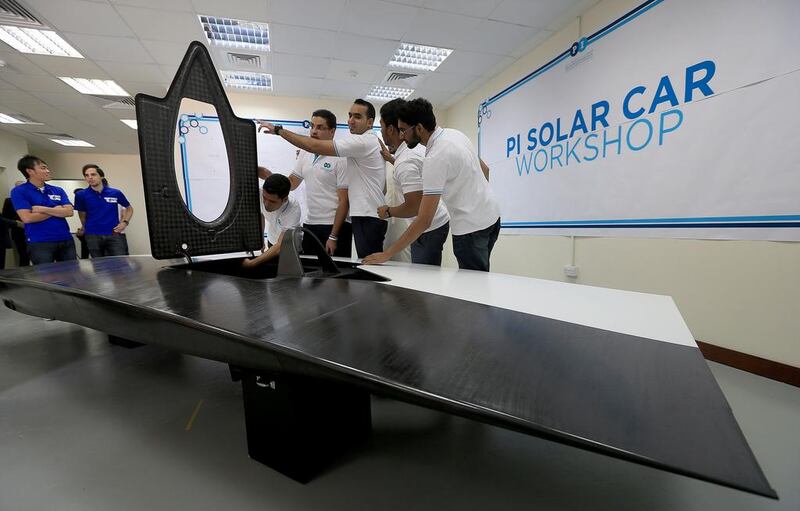ABU DHABI // Alataqa Al Hanai says the biggest challenge in building a solar-powered car was not the mechanics, it was “keeping the team as one”.
“If you were to ask me what was the most difficult thing, I’d probably say solidarity,” said Mr Al Hanai, 22, a senior mechanical engineering student at the Petroleum Institute.
The team on Thursday inaugurated their workshop at the institute after a two-month workshop in Japan ended last month.
They are working with students and faculty from Japan's Tokai University to assemble the one-seat, 150-kilogram solar-powered car that they will use to compete in the Abu Dhabi Solar Challenge in January.
The students are the first UAE team to enter a car in a national event.
More than 20 university teams will compete in the four-day event to see which car can finish the 1,200-kilometre, cross-country route in the shortest time.
The local team members felt positive about their chances on their home turf, and hoped to attend the World Solar Challenge in Australia later next year.
“The car is really good. We have to manage our energy well,” said Asad Saeed, 20, a mechanical engineering student from Pakistan.
The three-wheeled car can hold an 80kg driver and, in theory, can drive at up to 150kph, said Mr Saeed, the engineering director. The car is 4.9 metres long and 1.6 metres wide.
The team is still waiting for the tyres, which are in Customs, and delivery of the solar cells from the US.
The car’s body will have 390 solar cells in 16-part modules, with each cell measuring 125 millimetres by 125mm.
Students will have to predict the weather before the event and estimate how much energy will be needed throughout, said Mr Saeed.
Seventeen core members of the team, all mechanical or electrical engineering students, worked on the project.
Nine of them travelled to Japan to work on the design under the Tokai team’s supervision.
This included making the carbon-fibre parts for the car chassis and body, and the car’s electrical and battery systems.
They visited solar-car teams from institutions including Kanagawa Institute of Technology, Ashiya University and Osaka Institute of Technology, and with the University of Michigan team from the US.
The Japanese team is staying in the UAE to work with the Petroleum Institute students for a month.
“It’s actually really interesting to have such different cultures working on the same project,” said Abdulrahman Al Khatib, 26, a Saudi chemical engineering student at Tokai University.
“It was tough in the beginning, but overall, the experience is really helpful for both teams.”
Team members were selected through interviews.
After an introductory course, they assigned roles, evaluated them and reassigned if necessary, said Fahad Almaskari, adviser and assistant professor of mechanical engineering at the institute.
They had to create the structure of the team and boost their knowledge about solar-powered cars, said Mr Almaskari.
“We managed to build a very strong team both in terms of team structure and mechanical skills,” he said.
The Petroleum Institute is affiliated with the Abu Dhabi National Oil Company (Adnoc). The Tokai University students’ visit was sponsored by Japan Oil Development.
The world’s first solar car was developed in the US in 1955.
lcarroll@thenational.ae






